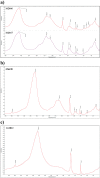Phytoliths as an indicator of early modern humans plant gathering strategies, fire fuel and site occupation intensity during the Middle Stone Age at Pinnacle Point 5-6 (south coast, South Africa)
- PMID: 29864147
- PMCID: PMC5986156
- DOI: 10.1371/journal.pone.0198558
Phytoliths as an indicator of early modern humans plant gathering strategies, fire fuel and site occupation intensity during the Middle Stone Age at Pinnacle Point 5-6 (south coast, South Africa)
Abstract
The study of plant remains in archaeological sites, along with a better understanding of the use of plants by prehistoric populations, can help us shed light on changes in survival strategies of hunter-gatherers and consequent impacts on modern human cognition, social organization, and technology. The archaeological locality of Pinnacle Point (Mossel Bay, South Africa) includes a series of coastal caves, rock-shelters, and open-air sites with human occupations spanning the Acheulian through Middle Stone Age (MSA) and Later Stone Age (LSA). These sites have provided some of the earliest evidence for complex human behaviour and technology during the MSA. We used phytoliths-amorphous silica particles that are deposited in cells of plants-as a proxy for the reconstruction of past human plant foraging strategies on the south coast of South Africa during the Middle and Late Pleistocene, emphasizing the use and control of fire as well as other possible plant uses. We analysed sediment samples from the different occupation periods at the rock shelter Pinnacle Point 5-6 North (PP5-6N). We also present an overview of the taphonomic processes affecting phytolith preservation in this site that will be critical to conduct a more reliable interpretation of the original plant use in the rock shelter. Our study reports the first evidence of the intentional gathering and introduction into living areas of plants from the Restionaceae family by MSA hunter-gatherers inhabiting the south coast of South Africa. We suggest that humans inhabiting Pinnacle Point during short-term occupation events during Marine Isotope Stage (MIS) 5 built fast fires using mainly grasses with some wood from trees and/or shrubs for specific purposes, perhaps for shellfish cooking. With the onset of MIS 4 we observed a change in the plant gathering strategies towards the intentional and intensive exploitation of dry wood to improve, we hypothesise, combustion for heating silcrete. This human behaviour is associated with changes in stone tool technology, site occupation intensity and climate change.
Conflict of interest statement
The authors have declared that no competing interests exist.
Figures








References
-
- Marean CW. An Evolutionary Anthropological Perspective on Modern Human Origins. Annu Rev Anthropol. 2015;44:533–56.
-
- Marean CW, Bar-Matthews M, Bernatchez JA, Fisher EC, Goldberg P, Herries AIR, et al. Early human use of marine resources and pigment in South Africa during the Middle Pleistocene. Nature. 2007;449:905–9. doi: 10.1038/nature06204 - DOI - PubMed
-
- Henshilwood CS, Sealy JC, Yates R, Cruz-Uribe K, Grine FE, Klein RG, et al. Blombos Cave, Southern Cape, South Africa: Preliminary Report on the 1992–1999 Excavations of the Middle Stone Age Levels. J Archaeol Sci. 2001;28(4):421–48.
-
- Brown KS, Marean CW, Herries AIR, Jacobs Z, Tribolo C, Braun D, et al. Fire as an engineering tool of early modern humans. Science (80-). 2009;325(5942):859–62. doi: 10.1126/science.1175028 - DOI - PubMed
-
- Mourre V, Villa P, Henshilwood CS. Early use of pressure flaking on lithic artifacts at Blombos Cave, South Africa. Science. 2010;330(6004):659–62. doi: 10.1126/science.1195550 - DOI - PubMed
Publication types
MeSH terms
LinkOut - more resources
Full Text Sources
Other Literature Sources
Miscellaneous

